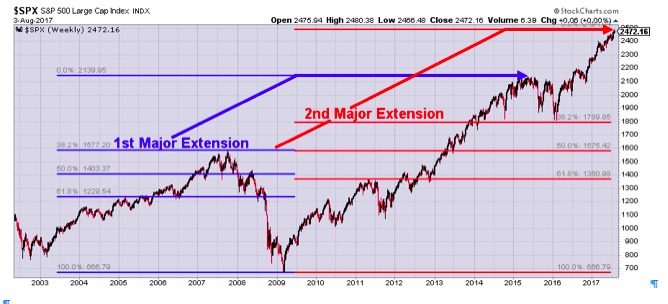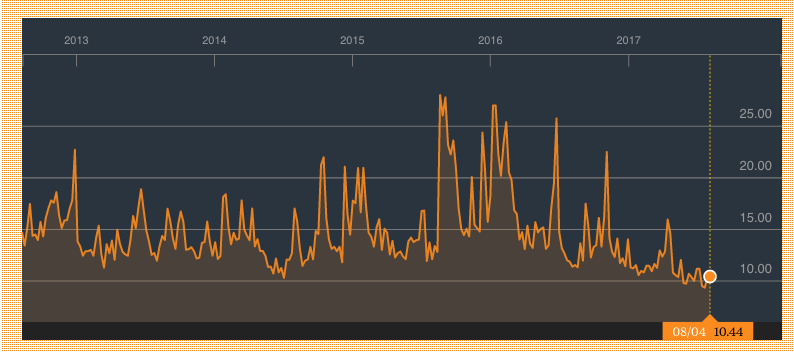Back in 2015 I wrote about the potential resistance from the first major Fibonacci extension from the 2007 peak.
The Fibonacci extension is a method that uses ratios that tend to repeat themselves in financial markets as a way to determine when a market peak or valley is more likely to occur. (Read previous article for more examples.)
The extension level from 2015 held for over one year (see blue lines and arrow), with two significant pullbacks during that year: one in August of 2015, and another in January of 2016.

Great Run
Since breaking above the 2015 resistance level, the market has been on a great run. Yet, in my opinion, it has just reached the next major Fibonacci extension from the 2007 peak (red lines/arrow).
Extensions can be discredited or validated by the peaks and valleys that interact with the three middle Fibonacci lines.
Notice on the chart above how the lows from January 2016 and October 2014 line up with the upper-middle red line, and how the 2007 peak lines up with the middle red line, and how the 2011 peak and November 2012 low aligns with the lower-middle red line.

High Valuations
This alignment is really strong, and makes me take this extension level very seriously.
There are other factors that warrant caution too. The cyclically adjusted price-to-earnings ratio, (CAPE) ratio is historically high.
This ratio compares the earnings of corporations to the price of the stock market, and by this measure the market has only been more expensive in the late 1990s (during the internet bubble), and in 1929 just before the great depression.
Additionally, the CBOE Volatility Index hit an all-time low last week. This measure is sometimes called the Fear/Greed index. And a low reading would tend to indicate high levels of greed and complacency.

Takeaway
Lastly, on a seasonal basis, we’re entering the time of year when the market has a tendency to be more volatile (August-October).
For all these reasons, in my opinion, it might be a good time to take some profits and be more cautious over the coming months in order to take advantage of better buying opportunities that could be coming in the near future.
Photo Credit: Robin Corps via Flickr Creative Commons
Please note that there is no formula guaranteed to predict future market movements and we cannot assure anyone that this article accurately predicts future price movements. All investments involve the risk of loss, including loss of principal and a reduction in earnings.



